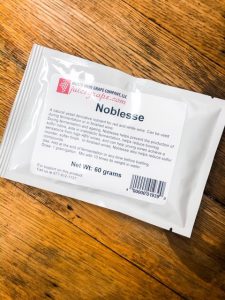Cellar Upgrades: Noblesse
Here is a great product you can use to help fix your wine..
Ever have a wine that’s high in alcohol?
That has a sharp tinge to the mouthfeel?
Then Noblesse is something you want to have in your cellar.
Noblesse is a natural nutrient that is used to help soften wines. Sometimes our grapes are high in brix an we can’t help but have a high alcohol wine. A by product of this is have a “burn” or “hot” sensation at the end of the palate. Or our wines are tasting a little too “sharp” for our liking.
Adding a dose of Noblesse will help soften your wine’s mouthfeel giving the perception of a rounder, silky mouthfeel, while reducing any sulfur smells and any burning sensation from high alcohol wines. Noblesse also helps aid in malolactic fermentation, so you can use this even if your wine is still going through malo.
We hope you consider adding Noblesse to you winemaker’s toolbox!
Hope to see you soon!
www.juicegrape.com – 877.812.1137 – sales@juicegrape.com
Good Brett vs. Bad Brett in a Wine
What is Brettanomyces?
Brettanomyces or ‘Brett’ as it’s called in the fermentation world is a yeast. When Brettanomyces grows in a wine it produces several compounds that can severely alter the wine’s taste and smell. There are several hundred species of Brettanomyces, and the type of Brett, as well as the amount present, can contribute positive or negative characteristics to a wine.
When is Brettanomyces or “Brett” good in a wine?
At low levels some winemakers agree that the presence of these compounds has a positive effect on the wine. Sommeliers and wine drinkers alike consider a small influence from Brett can give wines “old world” complexity and aged an characteristic to some young red wines. There are not many white wines that benefit from a Brett influence. Some winemakers are allowing for Brett to come through in Orange wines and spontaneously fermented whites. The jury is still out on if this is a positive or negative in white wines.
Brett is an “old world” aroma associated with several wine regions; mostly located in Europe. These regions are, but not limited to, Bordeaux, Côtes du Rhône, some Italian wines, some Spanish wines, some Chilean wines, and a few classic wineries in Napa. Many Paso Robles “Rhone Ranger” winemakers are introducing brett to their wines too.
-
Positive “Brett” Descriptors:
- Bacon
- Funk
- Gamey
- Smoke
- Leather
- Old World
- Farm yard
- Cured meats
- Saddle
- Spice
- Cloves
How does Brett become a Fault in wine?
Brettanomyces, if not contained, can turn into a spoilage yeast cell that is incredibly dangerous to the wine and difficult to eliminate. Most often it is found in contaminated barrels, is a product of bad winery cleanliness, and is resistant to acid and SO2. Large amounts of the Brett yeast will nearly completely disguise other flavors of the wine and produce negative off aromas and flavors.
-
Negative “Brett” Descriptors:
- Band-Aid
- Barnyard
- Sweaty gym socks
- Rancid cheese
- Horse stables
- Antiseptic
So the debate continues! What do you think?
Is Brett a friend or foe?
**PLEASE NOTE – We DO NOT suggest introducing Brett into your winery environment.
Our next Winemaker Faults & Flaws Class will be in the Spring of 2020!
We will go over how to avoid Brett, how to distinguish between the population sizes of positive and negative attributes in your wine, the steps you can take to extinguish brett in your winery, and much much more! Email cmusto@juicegrape.com to sign up.
Musto Wine Grape Company is here to help! We are New England’s largest supplier for home winemaking products and services. We can get you set up with all of your juice, grape and equipment needs and have you on track to making your own perfect pairing for next fall! Visit juicegrape.com or give us a call at (877) 812 – 1137 to learn more. We look forward to hearing from you!
Showcase Your Wines!
Don’t forget about the Musto Wine Grape – Amateur & Commercial 2017 Wine Competition! All wines are tasted and judged in Riedel glassware by the Top Wine Tasting & Winemaking Judges on the East Coast! Lots of feedback, tasting notes, and prizes. Sign up today! Your wine could win Best in Show!
Click HERE to download your Competition Documents.
The Winemaker’s Think Tank: Vol 12- Common Winemaking Faults and Flaws
What’s the Winemaker’s Think Tank?
Every Thursday we will post about a few frequently asked questions that our winemaker has answered. If you have a winemaking question you would like to have answered, please email us at support@juicegrape.com and we will try to get into next week’s post. Cheers! 🙂
In this week’s Winemaker’s Think Tank we outline the difference between flaws, faults, and how to identify them.
- Flaws
- Flaws are a mistake made in the winemaking process that leads to a property in the wine that is not characteristic of the varietal
- Stylistic Choice vs. Flaw
- Imbalance Flaw
- Acid vs Sugar, Oak Levels, Alcohol Level
- Visual Flaws
- Haze, Sediment, Effervescence, TA Crystals, Floaters, Lack of Color Saturation
- Aroma/Bouquet Flaws
- Lack of Aroma, Non-varietal aroma, Over-oaking
- Faults
- Faults are often a microbial or chemical reaction within the wine in some part of its life that significantly alters a wine, eventually leading to the point of spoilage.
- Oxidation Faults
- Acetaldehyde – oxidation of Ethyl Alcohol smells like sherry, or old apples, browning
- Causes: headspace, low sulfites, poor corks, bacterial contamination
- Acetic Acid – Vinegar
- Causes: Acetaldehyde, Acetobacter bacteria react with ethanol, Fruit Flie
- Ethyl Acetate – Nail Polish Smell
- Oxidation of Acetaldehyde and Acetic Acid
- Causes: headspace and bacterial contamination
- Acetaldehyde – oxidation of Ethyl Alcohol smells like sherry, or old apples, browning
- Sulfur Faults
- Hydrogen Sulfide – Rotten Eggs Smell
Causes: lack of yeast nutrients, yeast stress, sulfur sprays, yeast bi-product, high temps - Sulfur Dioxide – Burnt Match Smell
Causes: over sulfating, wild yeast - Complex Sulfur Faults- Mercaptans, DMS, DES, DMDS, DEDS
Causes: Hydrogen Sulfide reacting with Ethyl Alcohol
- Hydrogen Sulfide – Rotten Eggs Smell
- Microbial Faults
- Brettanomyces – Barnyard, Horse Saddle, Antiseptic Ointment, Band-Aids, Bacon, Clove
- Causes: spoilage yeast cells that are incredibly dangerous and difficult to eliminate. Most often found in contaminated barrels, winery cleanliness, resistant to acid and SO2
- Geranium Taint – Fresh cut geranium leaves
- Causes: Reaction of potassium sorbate with Lactic Acid Bacteria in the presence of Ethyl Alcohol
- Refermentation – Fizzy wine, popped corks
- Causes: Yeast or microbial fermentation of residual sugar
- Brettanomyces – Barnyard, Horse Saddle, Antiseptic Ointment, Band-Aids, Bacon, Clove
- Other Faults
- Cork Taint – Wet basement, wet old newspaper, mildew
- Causes: strain of trichloanisole on cork (cork taint); mold that contacts chlorine and wood
- Heat Damage – Cooked fruit smell, brick red color, similar to oxidation
- Causes: leaving wine in a hot car, in the sun, etc.
- Cork Taint – Wet basement, wet old newspaper, mildew
We hope this information helps with your winemaking. If you have any follow up questions or winemaking questions in general, please email us at support@juicegrape.com.













Recent Comments